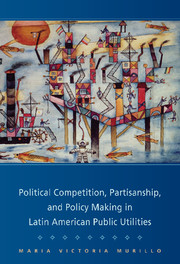Book contents
- Frontmatter
- Contents
- List of Acronyms
- Acknowledgments
- Introduction
- 1 Voice and Light
- 2 Political Competition and Policy Adoption
- 3 Casting a Partisan Light on Regulatory Choices
- 4 Postreform Regulatory Redistribution in Chile
- 5 Postreform Regulatory Redistribution in Argentina and Mexico
- 6 A Multilevel Analysis of Market Reforms in Latin American Public Utilities
- 7 Conclusion
- References
- Index
- Titles in the series
4 - Postreform Regulatory Redistribution in Chile
Published online by Cambridge University Press: 05 June 2012
- Frontmatter
- Contents
- List of Acronyms
- Acknowledgments
- Introduction
- 1 Voice and Light
- 2 Political Competition and Policy Adoption
- 3 Casting a Partisan Light on Regulatory Choices
- 4 Postreform Regulatory Redistribution in Chile
- 5 Postreform Regulatory Redistribution in Argentina and Mexico
- 6 A Multilevel Analysis of Market Reforms in Latin American Public Utilities
- 7 Conclusion
- References
- Index
- Titles in the series
Summary
In analyzing the consequences of market-oriented reforms, private providers emerge as crucial stakeholders in the defense of the conditions under which they decided to make their original investment decisions. This study focuses on the preferences of policy makers, as opposed to relational and institutional approaches to the study of public utilities, which focus on private investors' preferences, but it includes providers' preferences and bargaining power as constraints on policy makers' actions. This chapter and the one that follows have two goals. First, they test the explanatory power of the two main hypotheses for the postreform period; that is, taking advantage of longitudinal changes in electoral competition and partisanship within the same national context. Second, they seek to assess the institutional effects generated by the market-oriented reforms of public utilities in Argentina, Chile, and Mexico, with a focus on policy makers' and providers' preferences in explaining subsequent regulatory outcomes.
The dependent variable in both chapters is regulatory redistribution, which is measured using the four categories introduced in Chapter 1. These categories capture redistribution between the first entrants who became privatized incumbent providers and either their potential challengers or consumers. The four categories include “regulatory capture,” involving redistribution from consumers to providers; “regulatory dominance,” which generates redistribution in the opposite direction; “market dominance,” where redistribution goes from competitors to incumbent providers; and “market competition,” a case in which competitors benefit at the expense of incumbent providers.
- Type
- Chapter
- Information
- Political Competition, Partisanship, and Policy Making in Latin American Public Utilities , pp. 145 - 177Publisher: Cambridge University PressPrint publication year: 2009

